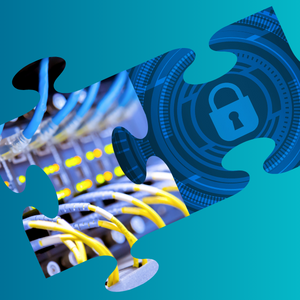
Client Architect, Networking
In the rapidly evolving digital landscape, the once-clear boundaries between network resilience and cybersecurity are increasingly blurred. These two critical areas have become interdependent, each reinforcing the other to create a robust defense against the myriad of threats targeting modern businesses.
A solid security stance in today’s digital age demands a holistic approach, recognizing how network resilience and cybersecurity not only coexist but support and enhance one another. This synergy is essential for safeguarding data, protecting customer trust, and ensuring business continuity.
Despite advancements in technology designed to meet the demands of a “distributed everything” environment, many organizations still cling to a “set it and forget it” mindset when it comes to their networks. This outdated approach overlooks a critical reality: approximately 70% of cyber threats begin at the network level. This makes the network not just a component of the IT infrastructure but a prime target and the preferred onramp for cyber adversaries aiming to access corporate information.
Moving away from this antiquated perspective is not just advisable; it’s imperative. Networks must be viewed as dynamic entities, requiring ongoing attention, adjustment, and fortification to counteract the sophisticated strategies employed by modern cyber threats.
Understanding the Symbiosis of Network Resilience and Cybersecurity
 Network resilience is the foundation upon which cybersecurity measures are built. It ensures that the network maintains an acceptable level of service despite challenges and threats, from hardware failures and software bugs to human errors and cyber-attacks. But resilience is not just about prevention; it’s about swift response and recovery.
Network resilience is the foundation upon which cybersecurity measures are built. It ensures that the network maintains an acceptable level of service despite challenges and threats, from hardware failures and software bugs to human errors and cyber-attacks. But resilience is not just about prevention; it’s about swift response and recovery.
Breaking Free from “Set It and Forget It”
The notion that once a network is set up, it can be left unchanged is a dangerous misconception. In an era where cyber adversaries continually evolve their tactics, a static network is a vulnerable network. Embracing a proactive, dynamic approach to network management and security is crucial. This means regular updates, continuous monitoring, and an adaptable security strategy that evolves in tandem with emerging threats.
Building Blocks of a Resilient and Secure Network
Redundancy and Failover Systems
Redundancy is not just a backup plan; it’s a business continuity strategy. Implementing redundant systems and failover mechanisms ensures minimal downtime, keeping operations running even when parts of the network fail.
Regular Updates and Patch Management
An unpatched system is a welcome sign for cybercriminals. Keeping software and systems updated with the latest patches is essential for closing the doors to known vulnerabilities.
Comprehensive Monitoring and Anomaly Detection
Visibility is key in cybersecurity. Continuous monitoring of network traffic and activities allows for the early detection of unusual patterns or potential threats, enabling proactive responses before they escalate.
Advanced Threat Protection
Cybersecurity strategies must evolve to address the spectrum of threats in the interconnected world.
- Multi-Vector Protection: While endpoint security is table stakes, up-leveling your defense requires a comprehensive approach that covers all threat vectors—extended detection and response (XDR). The concept behind the “X” in XDR is to secure your environment across all threat vectors.
- 24×7 Security Operations Center (SOC): Tools alone aren’t enough. You must have human experts monitoring your network around the clock, ready to respond to any threat.
- Continuous Incident Response and Pen Testing: Stay ahead of attackers with Continuous Incident Response and Continuous Pen Testing. Annual penetration testing solely reveals vulnerabilities 1 day out of 365.
- Zero Trust Network Access (ZTNA): Adopting a Zero Trust approach ensures that no entity inside or outside the network is trusted by default, significantly reducing the attack surface.
Layered Security Strategies
- Email Security: Implement advanced email filtering solutions to protect against phishing and malware distribution through email.
- DNS Security: 70-80% of email-based attacks rely on DNS to communicate with command and control session. Control and monitor DNS requests to prevent connections to malicious domains, disrupting the communication channels of many cyber threats.
- Micro-Segmentation: Ensure threats are quickly contained without disruption to the business. Divide the network into smaller, secure zones to limit lateral movement of attackers and contain breaches within isolated segments. I use an analogy from my days in the U.S. Navy to explain the concept in the video below.
Embracing Continuous Improvement
Cybersecurity is not a destination but a journey. Regular risk assessments, employee training, and an adaptive security posture are essential for staying ahead of threats.
DataEndure: Your Partner for Enhanced Network Security
The journey towards digital resilience is ongoing and requires continuous vigilance. For 40 years, DataEndure has been leading the way through change and helping our customers safeguard their critical assets with confidence.
We’re here to meet your business where it is and help it grow securely and resiliently. DataEndure’s complimentary Network Health Check is designed to assess your network’s current state and identify opportunities for enhancement, ensuring your infrastructure supports your organization today and into the future.